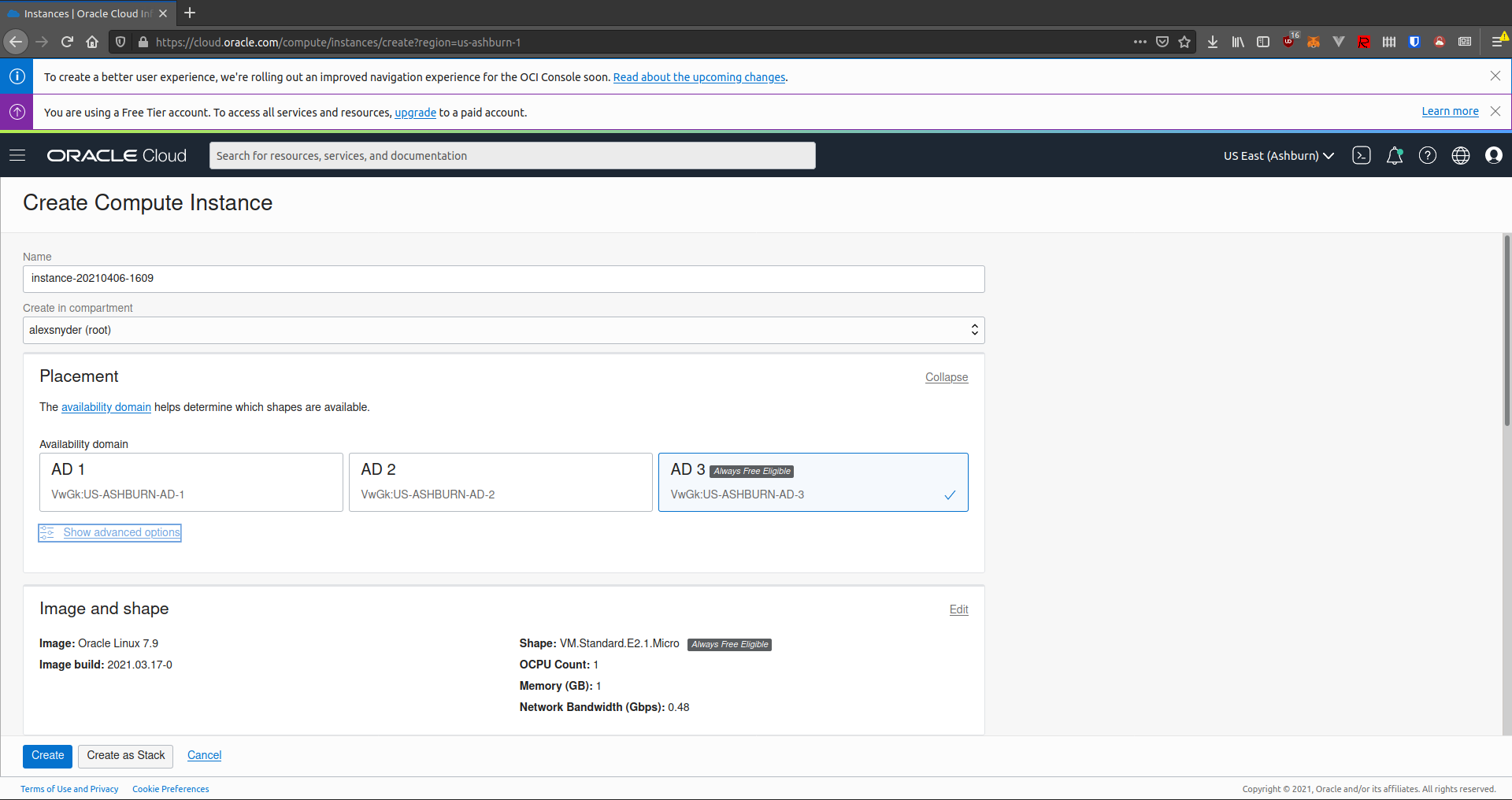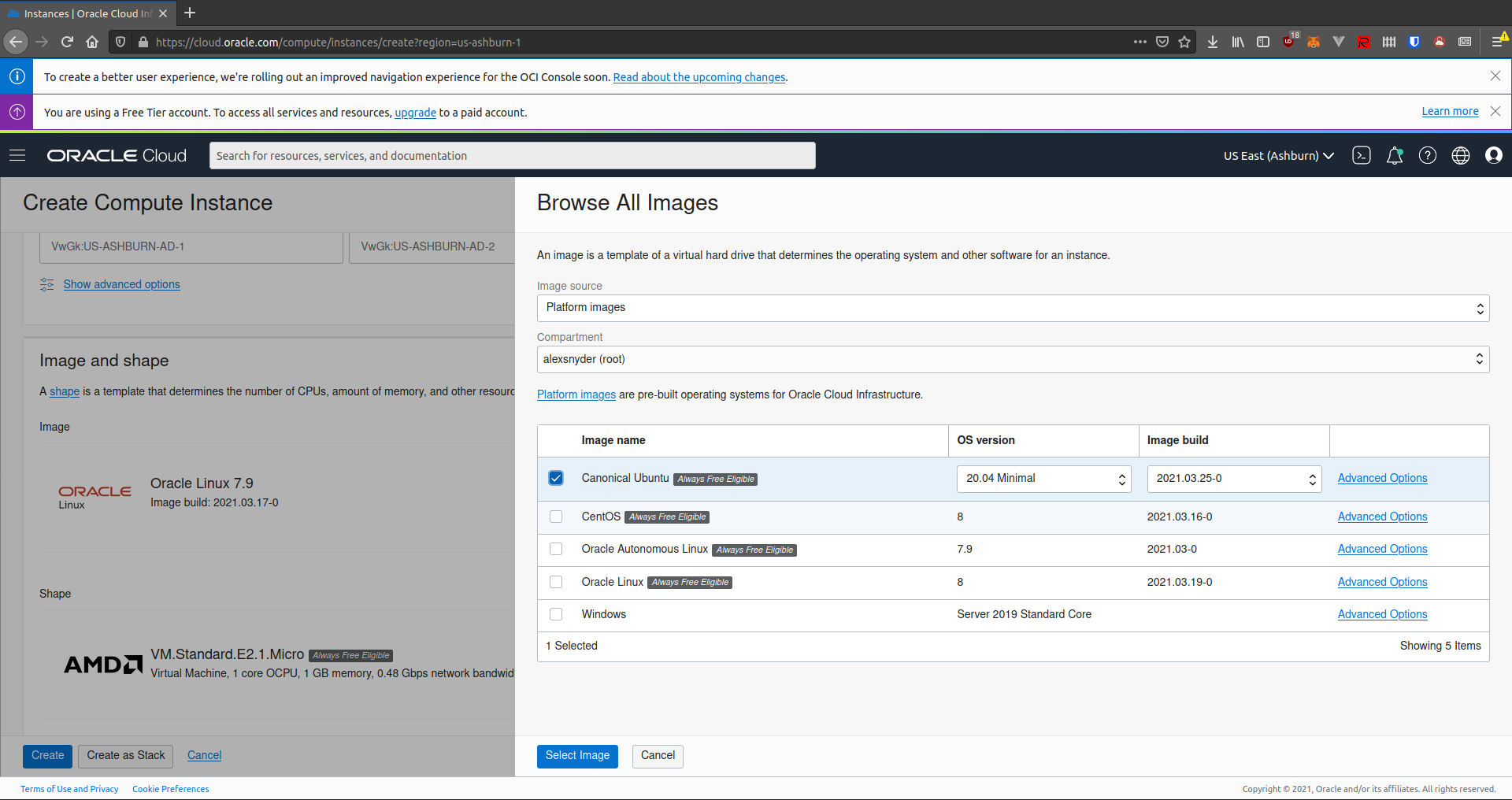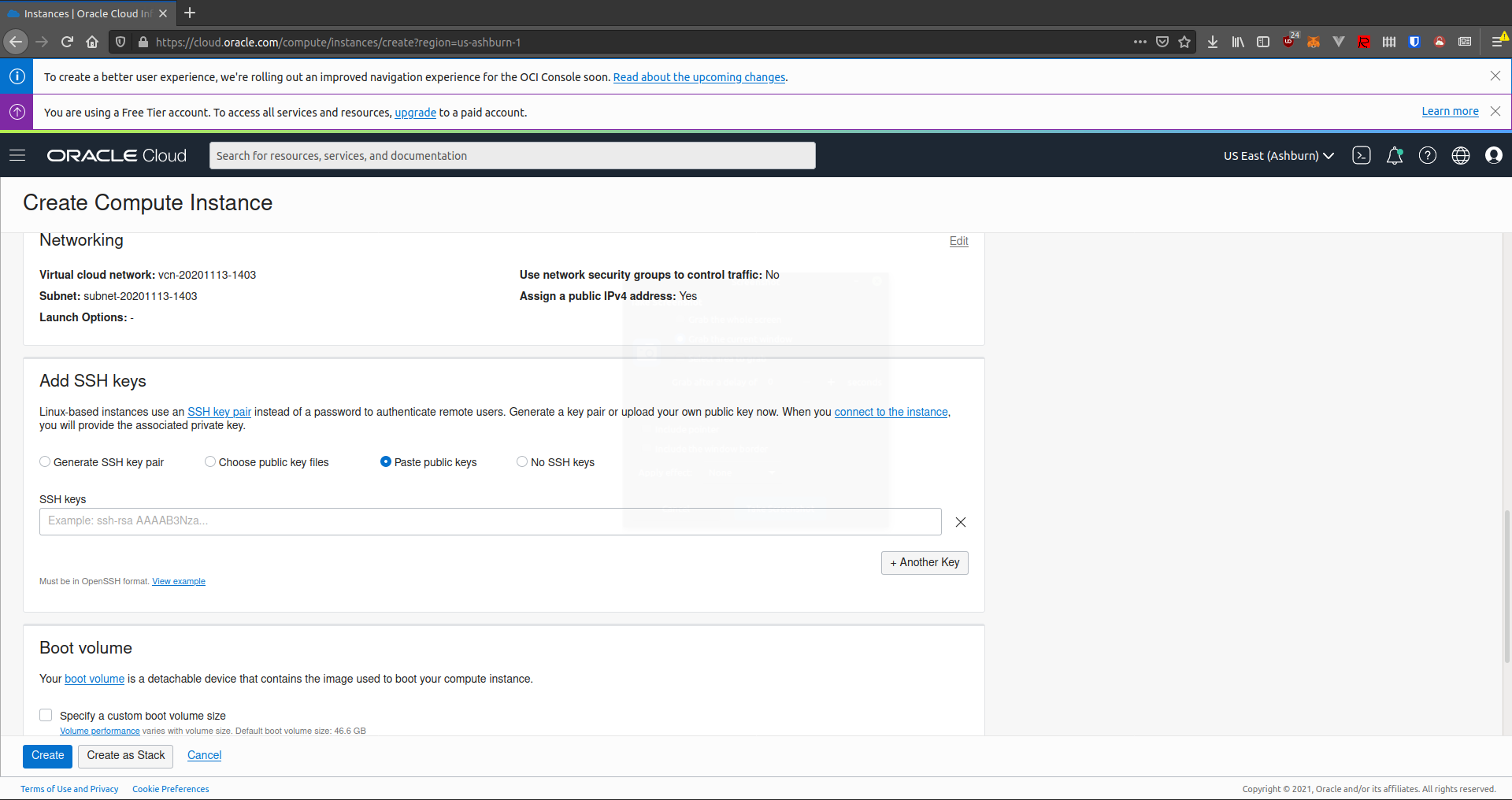Last active
November 11, 2025 05:33
-
Star
(136)
You must be signed in to star a gist -
Fork
(19)
You must be signed in to fork a gist
-
-
Save rssnyder/51e3cfedd730e7dd5f4a816143b25dbd to your computer and use it in GitHub Desktop.
Revisions
-
rssnyder revised this gist
Dec 7, 2021 . 1 changed file with 61 additions and 17 deletions.There are no files selected for viewing
This file contains hidden or bidirectional Unicode text that may be interpreted or compiled differently than what appears below. To review, open the file in an editor that reveals hidden Unicode characters. Learn more about bidirectional Unicode charactersOriginal file line number Diff line number Diff line change @@ -1,5 +1,12 @@ how to leverage oracle's temping offers ## free tier limits The limits of the free tier say that you can create up to 4 instances. - x2 x86 instances (2core/1g) - x2 ampere instances (with 4core/24g spread between them) - 200GB total boot volume space across all intances (minimum of 50G per instance) ## create your account The first step is to create your oracle cloud account here: https://signup.cloud.oracle.com/ @@ -14,42 +21,79 @@ Log into your new account you created above. ## create a vm instance On the home screen, there should be a hamberger button in the top left. Click it, and the resource pane opens. Select "Compute" and then "Instances".  Click on the "Create instance" button on the next page.  ## name & region Enter a name for your instance. Then give the form a second to autofill, and a region should be selected with the "Always Free-eligible" badge to the right.  ## shape Click "edit" next to "Image and Shape", and then "Change shape".  ### x86 To create an instance with an x86 based processor, just leave everything default and click "Select shape".  ### arm To create an instance with an arm processor, select "Ampere" and then check the box next to "VM.Standard.A1.Flex".  Then you are given a CPU and Memory slider. You have 4 cores and 24G to use between your (max of) 2 instances. You can give one instance all 4 cores and 24G or make two instances with a variable size.  ## image Click on "Change image" next.  This choice is personal preference. Choose the Image Name, OS, and Build based on what you need.  Then click "Select image" at the bottom. ## networking I usually don't change any defaults here, but you can at your discretion. ## ssh keys Next, under the ssh section, select "paste public keys" and paste in your public key (normally found in `~/.ssh/id_rsa.pub` in most \*nix like systems). You can also upload that file, or generate a key-pair from within the options.  ## boot volume Most of the time this section can be left as default.  You have 200G of disk space in the free tier, and if you use up 4 VMs then the minimum disk size of 50G (the default) is fine. If you plan to make fewer instances than 4, you can adjust the size as needed. ## deploy  You will be dropped to a loading screen, and after a few it will turn green and display a public ip that you can now `ssh` with the username `ubuntu` and the private key of the public one you specified above.  `ssh [email protected]` -
rssnyder revised this gist
Apr 29, 2021 . 1 changed file with 1 addition and 1 deletion.There are no files selected for viewing
This file contains hidden or bidirectional Unicode text that may be interpreted or compiled differently than what appears below. To review, open the file in an editor that reveals hidden Unicode characters. Learn more about bidirectional Unicode charactersOriginal file line number Diff line number Diff line change @@ -4,7 +4,7 @@ how to leverage oracle's temping offers The first step is to create your oracle cloud account here: https://signup.cloud.oracle.com/ You will need a valid credit card for signup, "We do not accept virtual cards or prepaid cards. We accept credit cards and debit cards only." ## login -
rssnyder renamed this gist
Apr 7, 2021 . 1 changed file with 0 additions and 0 deletions.There are no files selected for viewing
File renamed without changes. -
rssnyder created this gist
Apr 7, 2021 .There are no files selected for viewing
This file contains hidden or bidirectional Unicode text that may be interpreted or compiled differently than what appears below. To review, open the file in an editor that reveals hidden Unicode characters. Learn more about bidirectional Unicode charactersOriginal file line number Diff line number Diff line change @@ -0,0 +1,55 @@ how to leverage oracle's temping offers ## create your account The first step is to create your oracle cloud account here: https://signup.cloud.oracle.com/ You will need a valid credit card for signup, however I used a card I do not use and have "locked" and oracle has never attempted even a test charge. If you only have a debit card, you may be able to try something like https://privacy.com/, but I have not tested that yet. ## login Log into your new account you created above.  ## create a vm instance On the home screen, there should be an option to "create a vm instance". If not, you can select compute > instances from the left side menu.  ## region The form may take a second or two to load all the default values. This is important as it will select the region that is currently avalible for "always free" resources.  Make sure the region that is selected has the badge that reads "always free eligable". ## image and shape Click on "edit" next to "image and shape". This part is personal preference, but I perfer to select ubuntu as my OS, feel free to browse and select the one that works best for you.  Make sure the shape that is selected has the badge that reads "always free eligable". ## add ssh keys Next, under the ssh section, select "paste public keys" and paste in your public key (normally found in `~/.ssh/id_rsa.pub` in most \*nix like systems). You can also upload that file, or generate a key-pair from within the options.  ## deploy You should be finished will all the options that need to be set (feel free to customize other options, but some options will incurr charges so YMMV). You will be dropped to a loading screen, and after a few it will turn green and display a public ip that you can now `ssh` with the username `ubuntu` and the private key of the public one you specified above.  `ssh [email protected]` ## free tier limits The limits of the free teir say that you can create two of these VMs as we created above.